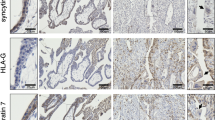Abstract
Fusiogenic glycoprotein syncytin-1, expressed in human placenta, is a promising candidate for acquiring a basic knowledge of placental syncytialization. However, its cellular mode of action is unidentified. We investigated whether syncytin-1 may exert influence on apoptotic processes. Therefore, we incubated CHO cells after stable transfection with syncytin-1 (CHO-52) in the presence or absence of staurosporine (STS), a kinase inhibitor well characterized to induce apoptosis. When testing the phenotype of CHO-52 cells, we could demonstrate that the induction of apoptosis by STS was delayed over a period of up to 24 h. Furthermore, the cell death rate was decreased by approx 75% following transfection of syncytin-1 in CHO-52 compared to mock-treated cells. In detail, after 18h of incubation with 500 nM STS, 64 ± 2% of CHO-52 cells were viable compared to 16 ± 1% of CHO-mocks, after 24 h 43 ± 3% vs 5 ± 2%, respectively. CHO-52 cells exhibited a lower expression of active caspase 3 and anti-apoptotic Bcl-2 was found to be increased in CHO-52 cells at baseline and following STS treatment.
Our study provides first evidence that syncytin-1 serves anti-apoptotic function under certain conditions. A lessened activation of caspase 3 and an increased expression of Bcl-2 are possible mechanisms.
Similar content being viewed by others
References
Mi S, Lee X, Li X et al (2000) Syncytin-1 is a captive retroviral envelope protein involved in human placental morphogenesis. Nature 403:785–89
Frendo JL, Olivier D, Cheynet V et al (2003) Direct involvement of HERV-W Env glycoprotein in human trophoblast cell fusion and differentiation. Mol Cell Biol 23:3566–574
Yu C, Shen K, Lin M et al (2002) GCMa regulates the syncytin-1-mediated trophoblastic fusion. J Biol Chem 277:50062–0068
Knerr I, Schubert SW, Wich C et al (2005) Stimulation of GCMa and syncytin-1 via cAMP mediated PKA signaling in human trophoblastic cells under normoxic and hypoxic conditions. FEBS Lett 579:3991–998
Knerr I, Weigel C, Linnemann K et al (2003) Transcriptional effects of hypoxia on fusiogenic syncytin-1 and its receptor ASCT2 in human cytotrophoblast BeWo cells and in ex vivo perfused placental cotyledons. Am J Obstet Gynecol 189:583–88
Hengartner MO (2000) The biochemistry of apoptosis. Nature 407:770–76
DiFederico E, Genbacev O, Fisher SJ (1999) Preeclampsia is associated with widespread apoptosis of placental cytotrophoblasts within the uterine wall. Am J Pathol 155:293–01
Redman CW, Sargent IL (2005) Latest advances in understanding preeclampsia. Science 308:1592–594
Hung TH, Skepper JN, Charnock-Jones DS, Burton GJ (2002) Hypoxia-reoxygenation: a potent inducer of apoptotic changes in the human placenta and possible etiological factor in preeclampsia. Circ Res 90:1274–281
Huppertz B, Kadyrov M, Kingdom JC (2006) Apoptosis and its role in the trophoblast. Am J Obstet Gynecol 195:29–9
Black S, Kadyrov M, Kaufmann P, Ugele B, Emans N, Huppertz B (2004) Syncytial fusion of human trophoblast depends on caspase 8. Cell Death Differ 11:90–8
Knerr I, Meißner U, Hashemolhosseini S (2005) Syncytin-1 and GCMa: Key regulators in human placental physiology and pre-eclampsia. Curr Women’s Health Rev 1:161–68
Das M, Xu B, Lin L, Chakrabarti S, Shivaswamy V, Rote NS (2004) Phosphatidylserine efflux and intercellular fusion in a BeWo model of human villous cytotrophoblast. Placenta 25:396–07
Zhang G, Yan G, Gurtu V, Spencer C, Kain SR (1998) Caspase inhibition prevents staurosporine-induced apoptosis in CHO-K1 cells. Apoptosis 3:27–3
Klaffenbach D, Rascher W, Rollinghoff M, Dotsch J, Meißner U, Schnare M (2005) Regulation and signal transduction of toll-like receptors in human chorioncarcinoma cell lines. Am J Reprod Immunol 53:77–4
Meißner U, Spranger R, Lehner M, Allabauer I, Rascher W, Dotsch J (2005) Hypoxia-induced leptin production in human trophoblasts does not protect from apoptosis. Eur J Endocrinol 153:455–61
Lehner M, Felzmann T, Clodi K, Holter W (2001) Type I interferons in combination with bacterial stimuli induce apoptosis of monocyte-derived dendritic cells. Blood 98:736–42
Knerr I, Beinder E, Rascher W (2002) Syncytin-1, a novel human endogenous retroviral gene in human placenta: evidence for its dysregulation in preeclampsia and HELLP syndrome. Am J Obstet Gynecol 186:210–13
Borges M, Bose P, Frank HG, Kaufmann P, Potgens AJ (2003) A two-colour fluorescence assay for the measurement of syncytial fusion between trophoblast-derived cell lines. Placenta 24:959–64
Skulachev VP (2006) Bioenergetic aspects of apoptosis, necrosis and mitoptosis. Apoptosis 11:473–85
Cheynet V, Oriol G, Mallet F (2006) Identification of the hASCT2-binding domain of the Env ERVWE1/syncytin-1 fusogenic glycoprotein. Retrovirology 3:41 [Epub ahead of print]
Levy R, Smith SD, Chandler K, Sadovsky Y, Nelson DM (2000) Apoptosis in human cultured trophoblasts is enhanced by hypoxia and diminished by epidermal growth factor. Am J Physiol Cell Physiol 278:C982–C988
Dash PR, Whitley GS, Ayling LJ, Johnstone AP, Cartwright JE (2005) Trophoblast apoptosis is inhibited by hepatocyte growth factor through the Akt and beta-catenin mediated up-regulation of inducible nitric oxide synthase. Cell Signal 17:571–80
Reynolds JE, Li J, Craig RW, Eastman A (1996) Bcl-2 and Mcl-1 expression in Chinese hamster ovary cells inhibits intracellular acidification and apoptosis induced by staurosporine. Exp Cell Res 225:430–36
Author information
Authors and Affiliations
Corresponding author
Rights and permissions
About this article
Cite this article
Knerr, I., Schnare, M., Hermann, K. et al. Fusiogenic endogenous-retroviral syncytin-1 exerts anti-apoptotic functions in staurosporine-challenged CHO cells. Apoptosis 12, 37–43 (2007). https://doi.org/10.1007/s10495-006-0329-9
Published:
Issue Date:
DOI: https://doi.org/10.1007/s10495-006-0329-9




